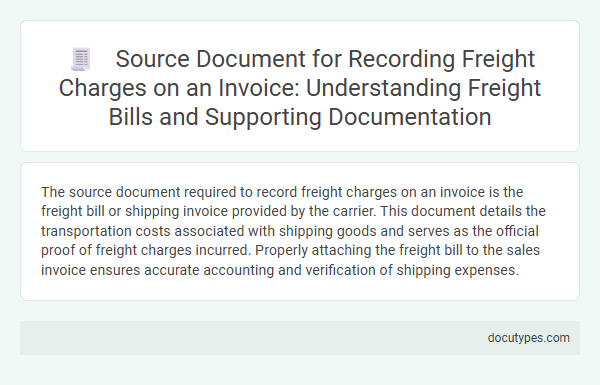The source document required to record freight charges on an invoice is the freight bill or shipping invoice provided by the carrier. This document details the transportation costs associated with shipping goods and serves as the official proof of freight charges incurred. Properly attaching the freight bill to the sales invoice ensures accurate accounting and verification of shipping expenses.
Introduction to Freight Charges in Invoicing
Which source document is required to record freight charges on an invoice? Freight charges are essential components that reflect the cost of transporting goods from the seller to the buyer. Accurate documentation of these charges ensures transparency and proper accounting in business transactions.
What is a Source Document in Freight Transactions?
A source document in freight transactions is the original record that provides evidence and details of the freight charges incurred. Common examples include bills of lading, freight bills, and carrier invoices, which outline shipment specifics, costs, and terms. You need these documents to accurately record freight charges on an invoice and ensure proper accounting and verification.
Types of Freight Bills: An Overview
Freight charges on an invoice must be supported by specific source documents known as freight bills. These documents provide detailed information about shipping costs, carriers, and shipment terms.
Common types of freight bills include carrier freight bills, third-party freight bills, and collect freight bills. Each type varies based on the billing party and payment responsibility, crucial for accurate invoice recording and auditing.
Key Information Included in Freight Bills
Freight charges on an invoice must be documented using the freight bill, which serves as the primary source document for these costs. This document validates the transportation fees and provides essential details for accurate accounting and payment processing.
- Carrier Information - Details of the shipping company responsible for transporting the goods.
- Freight Charges - Specifies the total cost incurred for shipping services.
- Shipment Details - Includes weight, dimensions, and description of the cargo.
Accurate recording of freight charges from the freight bill ensures transparency and proper financial tracking on the invoice.
Importance of Supporting Documentation for Freight Charges
Recording freight charges accurately on an invoice requires specific source documents to ensure transparency and proper accounting. Supporting documentation plays a crucial role in verifying the legitimacy of these charges and avoiding discrepancies.
- Bill of Lading - Serves as the primary source document detailing freight shipment terms and carrier responsibilities.
- Freight Invoice - Provides a detailed breakdown of freight costs, allowing verification against the charges recorded on the invoice.
- Proof of Delivery - Confirms receipt of goods and supports the inclusion of freight charges related to the shipment.
Steps to Record Freight Charges on an Invoice
To record freight charges on an invoice, the required source document is typically the freight bill or shipping receipt provided by the carrier. This document details the cost and terms of the freight service, enabling accurate accounting of shipping expenses.
First, verify the freight bill against the goods received to ensure accuracy. Next, enter the freight charges into your accounting system or invoice software as a separate line item. Finally, attach the freight bill to the invoice records to maintain proper documentation for auditing and payment purposes.
Common Supporting Documents for Freight Charges
To record freight charges on an invoice, you need specific source documents that verify the shipping costs. Common supporting documents include the Bill of Lading and Freight Bill.
The Bill of Lading acts as proof of shipment and details the carrier and goods transported. The Freight Bill provides a breakdown of the freight charges billed by the carrier, essential for accurate invoicing.
Compliance Requirements for Freight Documentation
The source document required to record freight charges on an invoice is typically the freight bill or delivery receipt issued by the carrier. Compliance requirements mandate that this document clearly itemizes shipping costs, originating and destination points, and shipment details to ensure accuracy and auditability. Maintaining these records is essential for verifying freight expenses and adhering to tax and regulatory standards.
Best Practices for Managing Freight Source Documents
Accurate recording of freight charges on an invoice requires the proper source document to ensure transparency and accountability. Managing these documents effectively supports smooth financial reconciliation and auditing processes.
- Bill of Lading - This document serves as proof of shipment and details the freight charges from the carrier to be recorded on the invoice.
- Freight Invoice - The official invoice from the transportation provider lists the cost breakdown and must be matched against your records for accuracy.
- Delivery Receipt - Confirms the receipt of goods and any additional freight-related charges that should be reflected on your invoice.
Which Source Document Is Required to Record Freight Charges on an Invoice? Infographic

